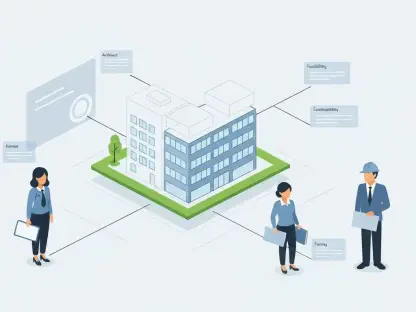Effective safety communication is essential for maintaining a safe, productive, and compliant working environment on construction sites. Given the dynamic and hazardous nature of these environments, clear and effective communication can significantly reduce risks and enhance safety outcomes. In the labyrinth of construction sites, with their ever-changing conditions and myriad hazards, the importance of well-orchestrated communication cannot be overstated. This article delves into the essential elements of effective safety communication, explores the challenges inherent to construction settings, and examines the roles different stakeholders play in fostering a safe work environment.
Construction sites are inherently complex and dynamic, with multiple organizations working together under constantly changing conditions. This complexity necessitates robust communication strategies to ensure that safety messages are conveyed clearly and understood by all parties involved. Site managers, safety practitioners, and team members must navigate a web of potential complications, from environmental barriers to interpersonal dynamics, to ensure that the message of safety remains unambiguous and actionable.
Key Elements of Safety Communication
The Communication Process
At the core of effective safety communication lies a fundamental understanding of the communication process. This process involves five essential elements: source, message, channel, receiver, and feedback. The source, or sender, encodes and transmits a message through a chosen channel, which the receiver then decodes and interprets. Feedback from the receiver helps the sender gauge the effectiveness of the communication and make necessary adjustments.
Safety communication starts with the source or the individual or entity initiating the message. This could be safety officers, supervisors, or any trained personnel tasked with conveying important safety instructions or identifying potential hazards. The message itself is the content being communicated – it ranges from specific instructions and warnings to general safety guidelines. Channels of communication in construction include face-to-face meetings, written notices, safety briefings, and digital communications like emails or mobile app notifications. Each channel comes with its advantages and challenges. The receiver is the worker or parties for whom the message is intended, and their interpretation of the message significantly impacts the outcome. Feedback from the receiver – whether through questions, compliance or non-compliance, or additional concerns – closes the loop, allowing the sender to refine and repeat the process if necessary.
Importance of Nonverbal Communication
Nonverbal communication plays a crucial role in how safety messages are received and interpreted. Elements such as body language, tone of voice, and facial expressions can significantly impact the effectiveness of the communication. Dr. Albert Mehrabian’s research highlights that nonverbal cues can either support or undermine verbal messages, making it essential for safety practitioners to be mindful of their nonverbal communication.
For instance, when a supervisor delivers a safety message with a confident tone and supportive body language, workers are more likely to take the message seriously and adhere to the guidelines. Conversely, if the same message is delivered with a dismissive or uncertain tone, the nonverbal cues might contradict the content of the message, leading to confusion or non-compliance. Nonverbal communication is not limited to in-person interactions; even in digital communications, elements such as punctuation, emojis, and formatting can convey tone and intent, influencing how the message is perceived. Effective use of nonverbal communication reinforces the importance of safety messages and helps foster a culture of attentiveness and adherence to safety protocols on construction sites.
Challenges in Construction Environments
Environmental Barriers
Construction sites present numerous environmental challenges that can obstruct clear communication. Noise from machinery, adverse weather conditions, and physical distances between workers can all hinder effective exchanges. These factors necessitate the use of adaptable communication strategies to ensure that safety messages are conveyed accurately.
Constant noise from heavy machinery can make it difficult for workers to hear verbal instructions or warnings. Weather conditions such as rain or extreme heat can affect the ability to communicate effectively, whether through physical discomfort or equipment malfunctions. Additionally, the physical expanse of many construction sites often sees workers operating at significant distances from each other, making face-to-face communication challenging without additional technological support like radios or public address systems. Overcoming these environmental barriers requires a combination of strategic planning and innovative use of technology to ensure that every worker receives and understands critical safety information.
Dynamic Work Conditions
The nature of construction work is characterized by daily changes and the involvement of multiple organizations. This dynamic environment adds layers of complexity to maintaining effective communication. Safety practitioners must be able to adapt their communication strategies to address the constantly evolving conditions on construction sites.
From day to day, the location of hazards can shift, new workers may join the team, and different stages of construction may introduce novel risks. This fluid environment demands flexibility in communication practices. Safety practitioners may need to conduct daily briefings, utilize mobile apps for real-time updates, or employ visual aids and signage to adapt to new conditions. The involvement of multiple organizations, each with its own communication practices and safety protocols, further complicates the communication landscape. Effective safety communication in such environments relies on creating cohesive policies that ensure consistency and clarity across all parties involved.
Roles and Responsibilities in Safety Communication
Project Supervision
Project supervision plays a critical role in overseeing construction efforts and ensuring that tasks are completed as scheduled. Supervisors are responsible for managing workers and maintaining productivity, but they must also prioritize safety. Effective communication between supervisors and workers is essential for identifying hazards and enforcing safe practices.
Supervisors often act as the linchpin between upper management’s directives and the workforce’s execution, making their role in safety communication indispensable. They are tasked with disseminating safety information, ensuring workers understand and follow safety protocols, and observing compliance on the ground. Their position grants them a unique vantage point to identify potential risks, assess worker behavior, and correct unsafe practices. By fostering an open line of communication, supervisors can encourage workers to voice concerns, ask questions, and report hazards, thus creating a proactive safety culture.
Safety Practitioners
Safety practitioners are tasked with identifying and mitigating hazards on construction sites. They conduct periodic site visits, assess conditions, and communicate necessary safety measures to both workers and supervisors. Despite their limited authority to enforce compliance, safety practitioners play a pivotal role in advocating for safe behaviors through persuasive and effective communication.
These professionals bring an expert perspective to hazard identification and risk management, often relying on established safety standards and regulations. Their communication duties involve not only informing workers of potential hazards but also educating them on best practices and preventive measures. Safety practitioners must use their knowledge and communication skills to influence behavioral change and foster a site-wide commitment to safety. Even without enforcement power, their persuasive abilities are critical in gaining buy-in from workers and supervisors alike, successfully integrating safety into the workflow.
Balancing Safety and Performance
Performance Goals vs. Safety Practices
Project supervision’s primary goal is to meet performance targets, which can sometimes conflict with safety practices. Workers may feel pressured to take shortcuts to achieve production goals, leading to unsafe behaviors. Safety practitioners must balance advocating for safe practices with the reality of performance demands, ensuring that safety is not compromised for productivity.
Supervisors, driven by the need to meet deadlines and budget constraints, might inadvertently prioritize productivity over safety, creating a tension between efficiency and security. However, it is crucial to recognize that a reduction in safety standards can lead to accidents, injuries, and long-term productivity losses. Safety practitioners can bridge this gap by integrating safety into performance goals. This could involve setting realistic timelines that account for safe work practices, incentivizing safe behavior, or demonstrating how safety compliance can lead to more sustainable productivity through fewer interruptions and higher worker morale. The alignment of safety and performance objectives can thus transform potential conflict into a synergistic relationship, enhancing both safety outcomes and overall project efficiency.
Collaborative Safety Efforts
Effective safety communication relies on collaboration between safety practitioners and project supervision. Both parties must work together to identify hazards, enforce safe practices, and ensure compliance without compromising productivity. This collaborative approach fosters a culture of safety and enhances overall safety outcomes on construction sites.
Joint efforts between supervisors and safety practitioners ensure that safety considerations are integrated into every aspect of the construction process. Regular meetings and open dialogues between these stakeholders can help in identifying potential risks early, developing mitigation strategies, and reinforcing the importance of safety to the workforce. Collaborative safety efforts also help in solving problems more efficiently, as both parties bring different perspectives and expertise to the table. A unified front on safety matters not only heightens compliance but also strengthens the message that safety is a collective responsibility shared across the entire construction site.
Overcoming Barriers to Communication
Positional Power Dynamics
Positional power dynamics can influence how safety messages are received and interpreted. Workers may be hesitant to voice concerns or ask questions due to perceived power imbalances. Safety practitioners must navigate these dynamics by fostering an open and inclusive communication environment where all parties feel comfortable sharing information.
Creating an inclusive communication culture requires safety practitioners to be approachable, empathetic, and open-minded. Workers are more likely to heed safety instructions and share concerns in an environment where their input is valued and respected. Supervisors and safety officers can hold regular meetings, conduct anonymous surveys, or establish suggestion boxes to gather worker feedback. Training programs focused on communication skills can also help supervisors understand their role in mitigating power imbalances, ensuring that safety messages are effectively conveyed and received without intimidation.
Personal Relationships and Environmental Factors
Personal relationships between the sender and receiver, as well as environmental factors such as the physical and psychological work climate, can impact communication effectiveness. Safety practitioners must be aware of these factors and tailor their communication strategies accordingly to ensure that safety messages are understood and acted upon.
Building trust is a cornerstone of effective safety communication. Workers are more likely to listen to and trust safety messages from individuals with whom they have positive relationships. Practitioners should take the time to build rapport with workers, understanding their concerns and perspectives. Environmentally, the worksite’s physical layout and conditions can also play a role. Factors like lighting, noise levels, and overall site organization influence how well messages are received. Strategic placement of safety posters, thoughtful scheduling of safety talks during quieter periods, and equitable treatment of all workers, regardless of their position, contribute to a culture of clear and effective communication.
Enhancing Communication Skills
Training and Development
Safety practitioners must possess strong communication skills to navigate the various challenges and barriers inherent in construction sites. Ongoing training and development can help practitioners enhance their communication abilities, enabling them to effectively convey safety messages and encourage safe behaviors.
Training programs aimed at improving communication skills can cover areas such as active listening, conflict resolution, and effective persuasion. Workshops, seminars, and role-playing exercises help practitioners develop the skills needed to convey complex safety instructions clearly and effectively. Continuous professional development is essential, as it keeps practitioners updated on the latest communication techniques and safety regulations. By investing in their communication capabilities, safety practitioners can become more effective advocates for safety, demonstrating their commitment to worker well-being and fostering a culture of continuous improvement.
Utilizing Technology
Advancements in technology can aid in overcoming communication barriers on construction sites. Tools such as mobile apps, digital signage, and real-time communication platforms can facilitate clearer and more efficient exchanges, ensuring that safety messages reach all workers promptly and accurately.
Digital tools enable safety practitioners to disseminate information quickly and monitor compliance in real time. Mobile apps can push notifications about potential hazards, weather alerts, or changes in safety protocols directly to workers’ smartphones. Digital signage placed strategically around construction sites can display critical safety information and updates, while real-time communication platforms allow for instant feedback and clarification. Embracing technology not only enhances communication efficiency but also demonstrates a commitment to leveraging modern solutions for worker safety.
By understanding the key elements of effective safety communication, addressing the challenges posed by construction environments, and fostering collaboration between safety practitioners and project supervision, construction sites can achieve a safer and more productive working environment. The integration of advanced communication strategies and tools, combined with a heartfelt commitment to safety, forms the bedrock of successful construction site management.









